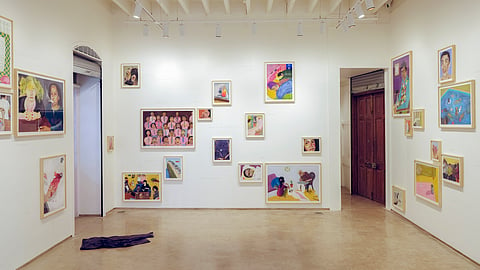How Indian artists are reshaping the contemporary art scene
India's new generation of artists is reshaping contemporary art scene and global presence

India’s contemporary art scene is undergoing a quiet revolution. Across galleries, residencies, community platforms, and public spaces, a new generation of artists is challenging conventional boundaries of practice and purpose.
No longer confined by the white cube or dictated by auction calendars, these artists are engaging with the urgencies of their time — ecology, caste, identity, and decolonisation — in deeply embedded, socially conscious, and often collaborative ways.
Their work is not just about what art looks like, but what it does — who it speaks for, where it lives, and how it participates in the world. It is a shift not just in medium or method, but in mentality.

“Artists respond to the time they live in,” says Smriti Rajgarhia, Director of Serendipity Arts, known for its interdisciplinary festivals, residencies, and community-based programming in Goa and South Asia.
“Today’s practitioners are exploring gender, gender fluidity, ecology, and indigenous knowledge systems with a sense of urgency and clarity that reflects their lived realities.”
A reflection of reality
This shift is rooted in both personal experience and political context. For Prabhakar Pachpute, whose family has been involved in coal mining for generations, the act of creation is inseparable from the politics of land and labour.
“I explore what happens before, during, and after mining,” says Pachpute. “It’s not just about extraction, but about what communities lose — agricultural memory, identity, and voice.”

His childhood in Sasti, a mining town in Chandrapur, Maharashtra, exposed him to the social dislocation and ecological damage brought about by mining. Today, his immersive charcoal installations and murals probe the deep costs of resource extraction and the erasure of collective memory.
“Initially, I thought of my work as documentation,” he adds. “But over time, it became resistance, a way to question dominant narratives about progress and development.”
This thread of resistance runs through the practice of Rathin Barman, whose architectural installations and material-driven works explore histories of migration, informal housing, and ecological displacement.
“Climate change is accelerating migration,” he says. “Cities are overwhelmed, and we’re losing traditional knowledge systems in the process.”
His latest project, Space Counts, which will be the subject of his next one-man show at the Experimenter Colaba in Mumbai, reflects on the evolution of urban living through drawn floor plans and sculptural forms inspired by Russian artist Kazimir Malevich.

Courtyards, once central to collective life, are vanishing, replaced by cramped, impersonal spaces, he says.
“I use construction materials like concrete and reclaimed wood not for permanence,” Barman says, “but to highlight decay and memory. The illusion of progress is crumbling — literally.”
While some artists confront systemic collapse head-on, others reclaim agency through materials and tradition. Desmond Lazaro, based in Australia but rooted in the miniature painting traditions of South Asia, uses handmade pigments and cartographic language to map personal and diasporic histories.
“Reclaiming your story is essential — otherwise someone else will tell it for you,” he says. “My work is about that act of reclaiming, through pigment, through place, through narrative.”

For Lazaro, working with natural materials is both political and spiritual.
Lazaro views his use of traditional materials like cinnabar not merely as a stylistic choice, but as a metaphysical one.
For him, grinding pigment by hand is “a connection to Mercury, to the cosmos — something ancient and sacred.” It’s both an artistic and spiritual act, rooted in presence.
His hybrid practice, encompassing public art, publications, and digital media, shows how tradition and innovation can coexist, not in tension but in dialogue.
“Digital tools are just that — tools,” he notes. “What matters is the intention, the process, the values embodied in the work.”
Supporting this pluralistic, purpose-driven shift are institutions like Experimenter in Kolkata. The art initiative, co-founded by Prateek Raja, has carved a niche for fostering research-led and politically attuned art.
Not just art, but action

“Artists today are taking on caste, climate, land rights, and decolonial critique in their own visual languages,” says Raja. “It’s important that these narratives travel — not just regionally, but globally.”
Experimenter has supported everything from Soumya Sankar Bose’s photo billboards in the Sundarbans to CAMP’s surveillance-media installations in Mumbai’s Sassoon Docks.
“The gallery is just one node in the ecosystem,” says Raja.
“We need to show art in public, in context, to reach the audiences who need it most.”
The gallery also runs a year-round learning programme to train curators, support critical writing, and expand discourse beyond metropolitan art circles.
“Decolonisation is not just a theme,” says Raja. “It’s a process of asking hard questions, of dismantling inherited hierarchies, including our own.”
For Rajgarhia at Serendipity Arts, access and equity are central. The organisation’s residencies, grants, and its flagship festival in Goa are designed to democratise both the production and experience of art.
“We’ve seen artists collaborate with craftspeople, non-artists, and local communities,” she says. “It’s not about the static object but the shared process — an archive of participation.”
Their upcoming festival features Thomas Zacharias’ multisensory food installation on biodiversity, a salt ecology project by Prahlad Sukhtankar, and Edible Issues’ journey into pastoral lives affected by climate change.
“These projects are symptomatic of the times,” Rajgarhia notes. “They show that artists are not just reflecting the world but reshaping it.”
Of course, working outside the traditional gallery system brings its own challenges — funding, logistics, institutional inertia. But it also opens new pathways.
“You have to rethink success,” she says. “It’s not about sales or Instagram likes — it’s about dialogue, relationships, social impact.”
Perhaps what unites this new wave of Indian art is not a shared aesthetic but a shared attitude: art as enquiry, as activism, as care. Whether it is mural, pigment, sculpture, sound, or storytelling, the emphasis is on relevance and responsibility.
“India’s contemporary scene is alive, complex, and expanding,” says Lazaro. “There’s no single voice — and that’s its strength.”
The Indian art world may still grapple with questions of access, representation, and institutional inertia, but a shift is undeniably underway.
Artists are reclaiming ground — literally and metaphorically — by telling stories that are hyperlocal and globally resonant.
What’s clear is that India’s artists are no longer waiting to be discovered by the West or explained through borrowed frameworks. They are claiming space — locally and globally — on their own terms. In doing so, they are not just rewriting art history. They’re writing the future.
Sign up for the Daily Briefing
Get the latest news and updates straight to your inbox


